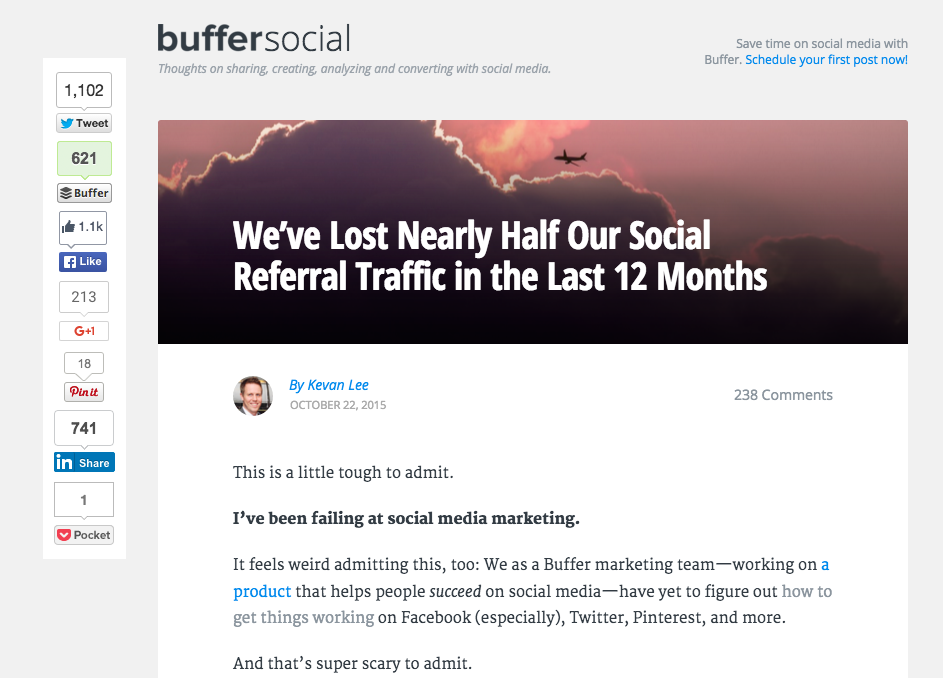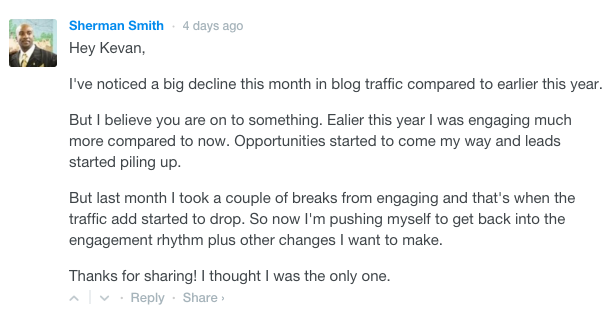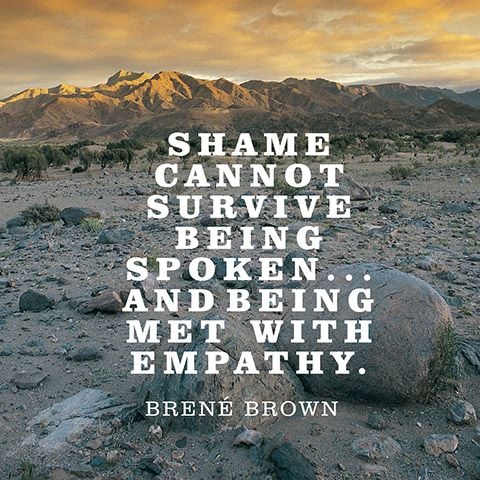The Best Time For Transparency Is When It’s The Hardest

Former Director of People @ Buffer
When people learn about our devotion to transparency at Buffer, there tends to be one big question that looms large.
Here’s the gist of it: “Transparency seems like a great policy when things are going great. But what about when they’re not?”
Ed Fry summed up this often-asked question quite perfectly during an “Ask Me Anything” session some of us Bufferers did over at inbound.org a while back:

There’s one element of my answer to Ed that I’d like to revise. Back then, I said that “transparency almost becomes more important when things aren’t going well.” Today, I’d remove the word “almost.”
Time and time again at Buffer, we’ve learned the unique lesson that sharing openly when it’s the very hardest thing to do—when every cell in your body fights back, when you linger over the “send” or “publish” button nearly paralyzed, when you might be physically shaking when you complete the mission (yup, this has happened to me before!)—creates the biggest benefits of all.
Recently, we learned it once again when we hit publish on this post during one of the scariest moments the Crafters team has ever had at Buffer.

In exchange for overcoming that moment of fear, we’ve been rewarded so richly.
- We’ve gotten tough, candid feedback that wasn’t easy to hear—but was crucial to know.
- We’ve been in touch with a variety of incredible industry thought leaders, who wanted to share their insights and puzzle through our situations with us.
Re: Buffer’s social traffic loss: https://t.co/j0LYsghMYO a few thoughts (purely my own speculation) on why…
— Rand Fishkin (@randfish) October 23, 20153) Twitter, Facebook, et al. have become more challenging sources from which to drive traffic. Clicks are just harder to come by. — Rand Fishkin (@randfish) October 23, 2015
- We’ve gotten entirely re-energized internally thanks to all the amazing support, advice and epiphanies that have been coming our way.
Now I have no doubt that transparency can not only survive during times of hardship—it can help you thrive.
We’ve shared many of the benefits of transparency already, and now I’d like to add to the list. If you’re contemplating transparency at your organization but wondering how it’ll work during the tough times, here are 3 big benefits I’d love to share.
1. Transparency humanizes
It wasn’t easy to admit we’re a social media company that doesn’t have social media figured out. But we faced our worst fear in public—and it turned out pretty OK!
That’s a powerful revelation, and it’s been true across the board.
I wasn’t on the team yet when Buffer got hacked, but it seems like if ever there was a moment to doubt the whole transparency thing, that might have been it. At every point, my instincts would likely have told me to lock it down, clam up and only communicate when everything is back to normal.
And yet, being transparent throughout a terrible situation was exactly how Buffer thrived even through its darkest days. In fact, we saw almost record numbers of signups following the breach as amazing old and new friends alike showed some truly incredible support.
We even got love notes like this in the blog comments:

Wow. The deep kindness and forgiveness we received from our community is a whole story in itself.
But I think the moral might be: When you show your mistakes, you make yourself vulnerable. And—somehow, counterintuitively—that makes others want to cheer for you.
2. Transparency frees us all from perfectionism
Sharing your mistakes also immediately frees you from the trap of perfectionism. Your track record is already blemished publicly, so you can stop trying to be the best at everything all the time. Now: anything goes!
What an incredibly liberating feeling.
And this awesome side effect isn’t just for the sharer—it’s for anyone who’d like to come right along with them.
One of the most rewarding responses to our recent “social media failure” article is how many people shared things like “I thought it was just me,” or “I assumed I was the only one.”

Transparency does something really beautiful here by bringing openness into a space where there once was shame.

Sharing stories of mistakes and failures lets us know we’re not alone, and that gives us the strength to move forward.
3. Transparency makes people want to help you
It’s amazing how many tips, insights and pieces of advice we’ve gotten over the past two weeks. It’s all great, and we’re going to synthesize and learn from every bit.
We could have sent out 100 emails to important marketers asking for advice, or asked 100 readers to fill out an in-depth survey, or even paid a firm to get to the bottom of this challenge. Even if we had done all those things, I’m not sure that we would have learned as much as we did, as quickly, simply by sharing our story—then sitting back and listening.
Without really realizing we were doing it, we gave our audience permission to tell us what they really thought of our work. And they did us a true kindness with each word.
A similar wonderful flood took place for me a while back when I got up the nerve to share some of the ways I was creatively failing and holding back because of fear. The useful tips, book suggestions and amazing encouragement I got could fill a book (and probably should).
Over to you
I want to hear you thoughts on every post I write, but I’m REALLY curious about your thoughts on this one. My experience with transparency is limited to Buffer, and I’m sure there are lots of situations that I’m not thinking of.
Have you ever shared something transparently that was really tough to share? How did you feel, and how did your community (or audience, or friends) accept it? Can you think of a time when transparency would make a rough time even rougher? Share it all in the comments!
Try Buffer for free
180,000+ creators, small businesses, and marketers use Buffer to grow their audiences every month.
Related Articles

What it was like to join a fully remote team like Buffer, and how going on the company retreat so early on helped shape my journey in ways I hadn’t imagined.

If you’ve followed Buffer for a while, then you know we have a few uncommon approaches to teammate benefits and compensation. The example I’ll dig into today is our “Dependent Grant,” which we launched in 2016. Our Dependent Grant is separate benefit, outside of salary, that we grant teammates who are taking care of and supporting family members. It’s an extra $3,000 USD per year per child, up to four dependents total. This has been one of our most unusual (and at times controversial) benefits

It can feel incredibly challenging to hire, and hire well. For one thing, hiring is usually a significant time investment for our small team — we once had 1,500 applications in just over a week for a content role (!!) — but beyond that, we are so intentional about the ways that we collaborate. Buffer is a fully remote, global, and culturally diverse company operating with a four-day work week. Finding someone who will thrive in our work environment, and is also highly skilled in the areas we’r